Updated Feb. 2024: Completely rewritten with all new models.
Want a heated debate? Ask a room full of shooters how much money you should spend on an optic.
Some will argue that the firearm matters way more than whichever piece of glass you put on top of it; others will point out that you can’t shoot what you can’t see, and some crusty old-timer in the corner will start mumbling about iron sights.
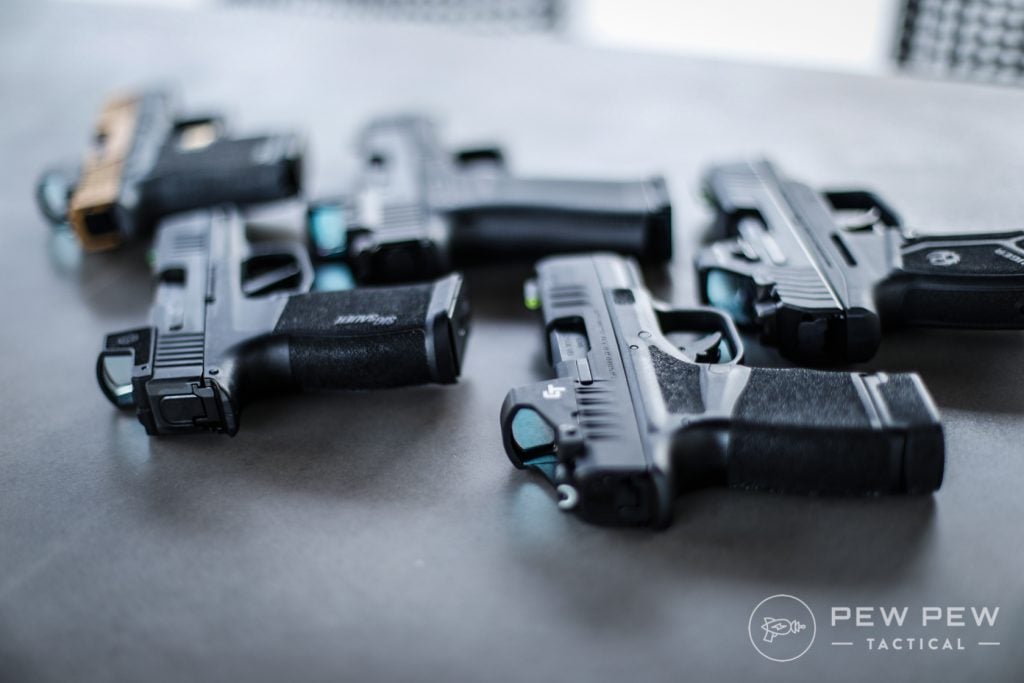
I lean toward getting the best optic you can afford, but I certainly wouldn’t scold someone for buying an entry-level red dot if the alternative is iron sights.
There are some solid options out there for people trying to find a quality optic with a budget of $200, and today, we’re going to take a look at a few.
So keep reading as we lay out our favorite models and tell you why they make the list.
THE QUICK LIST
-
Editor’s Pick
-
Best Value
-
Best Rifle Red Dot
-
Best Pistol Red Dot
Table of Contents
Loading…
How We Chose the Best Red Dots Under $200
Scott Murdock is a Marine Corps veteran with a basic working knowledge of shooting, written English, and photography. He’s passionate about helping readers find quality gear worthy of their money. You can find more of his work at Task & Purpose, Free Range American, and Outdoor Life.
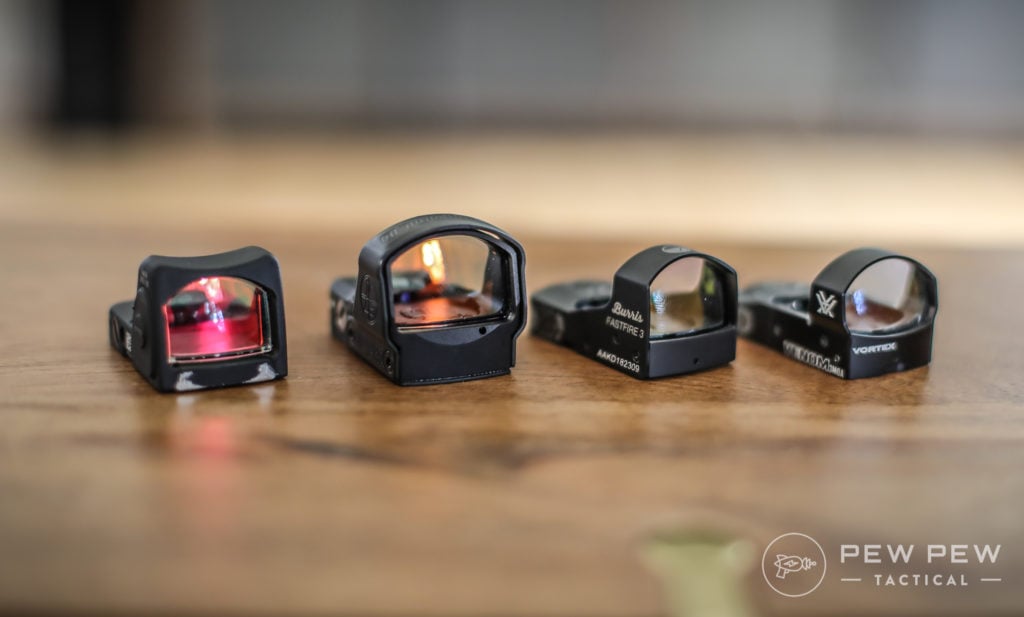
This article is a culmination of the best and most affordable red dots we think fit most people. We update articles regularly, so check back if your favorite isn’t listed (or drop us a comment below).
Best Red Dots Under $200
1. Sig Sauer ROMEO5
Prices accurate at time of writing
Prices accurate at time of writing
-
25% off all OAKLEY products - OAKLEY25
Copied! Visit Merchant
Pros
- Has shake awake tech
- Simple but effective design
- Waterpoof rated
Cons
- Limited features
- Might not be as rugged as other models
Specs
Features
For less than $200, it’s hard to do better than the Sig Sauer ROMEO5. Sig’s entry-level red dot feels like a more expensive optic than it is and will give you some room to grow into.
It seems pretty clear that when Sig designed the ROMEO5, the goal was to offer limited features but to make sure they worked very well. It has a simple 2 MOA red dot reticle with 10 brightness settings, a compact housing, and enough protection to keep it operational through daily bumps and splashes.
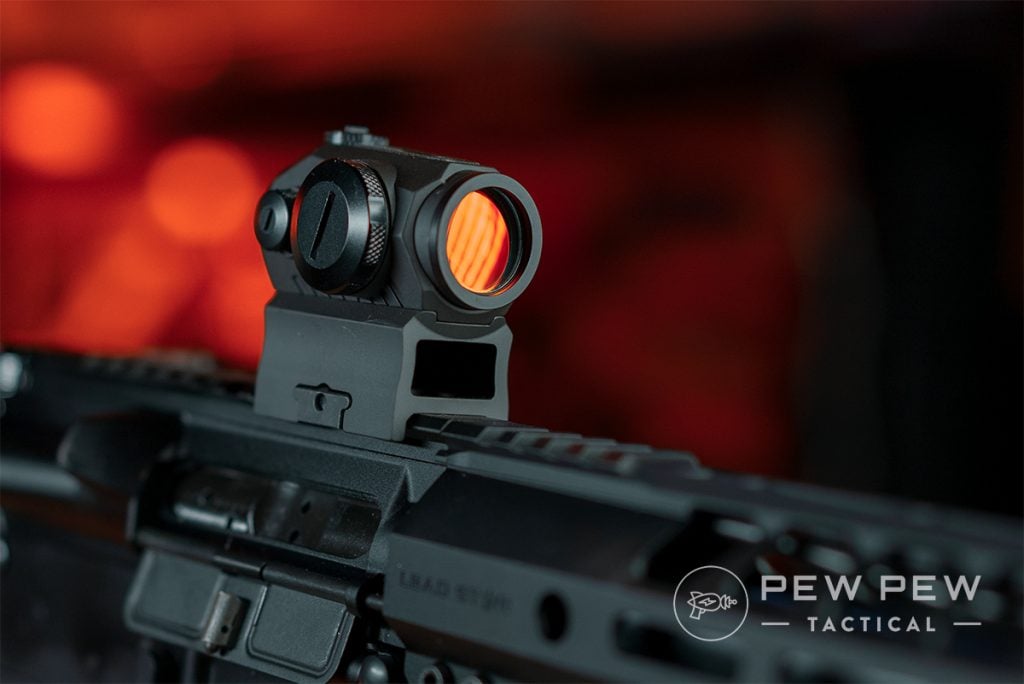
One higher-end feature that Sig included on the ROMEO5 is shake-awake. The optic will shut down when you’re not using it to save battery life, then wake itself up using the last-used setting when it detects motion. It’s a clever way to extend battery life that many optics in this price range don’t offer.
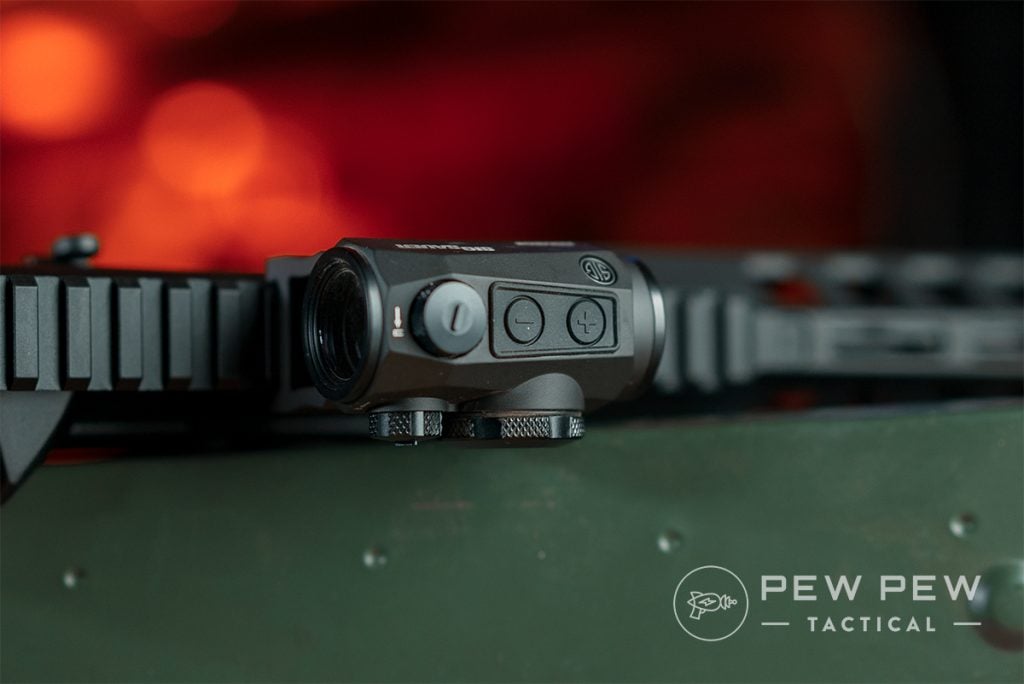
People who own the ROMEO5 typically give it very high marks for durability. It’s not necessarily what I’d consider a combat or duty optic, but its IPX7 waterproof rating and sturdy construction can handle whatever most recreational shooters dish out.
2. Holosun 403B
Prices accurate at time of writing
Prices accurate at time of writing
-
25% off all OAKLEY products - OAKLEY25
Copied! Visit Merchant
Pros
- Great value + features
- Long battery life
- Shake-awake tech
Cons
- No solar charging panel
Specs
Features
As usual, one of our favorite optic manufacturers found a way to make the Holosun 403B punch above its price and give shooters a great way to save money without sacrificing features.
Depending on the kind of sales, the Holosun 403B can be a more affordable alternative to the Sig Sauer ROMEO5. You’ll still get a 20-millimeter window, 2-MOA dot reticle, co-witness riser, long battery life, and shake-awake feature — you just won’t spend as much.
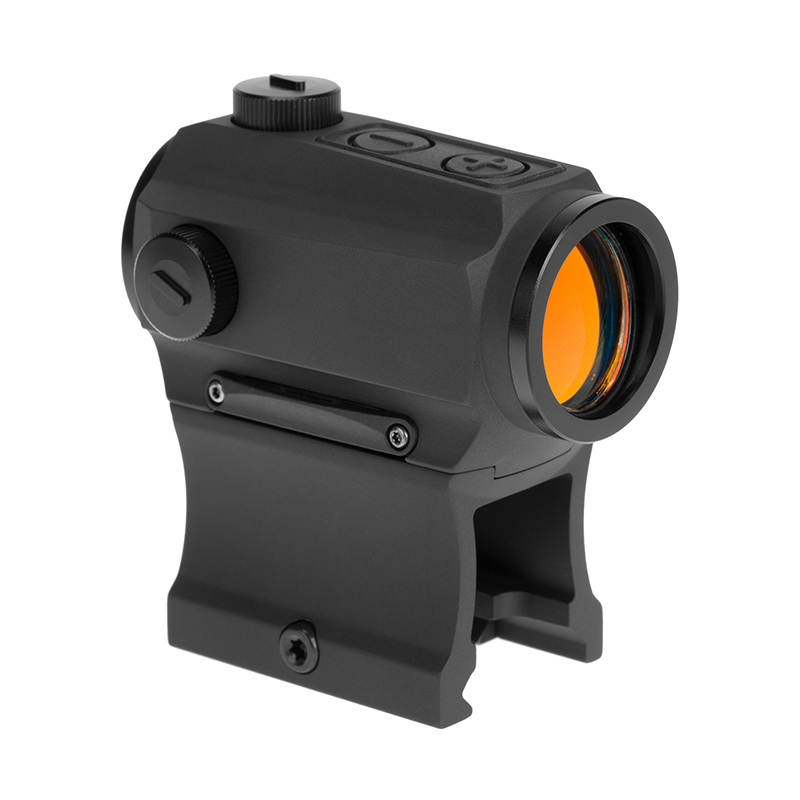
The 403B is the same size as the ROMEO5, but it’s lighter and stores the battery in a tray underneath the optic rather than on the side like the Sig.
Some of Holosun’s optics come with a solar charging panel that extends battery life, but you’ll have to break the $200 budget for that kind of tech.
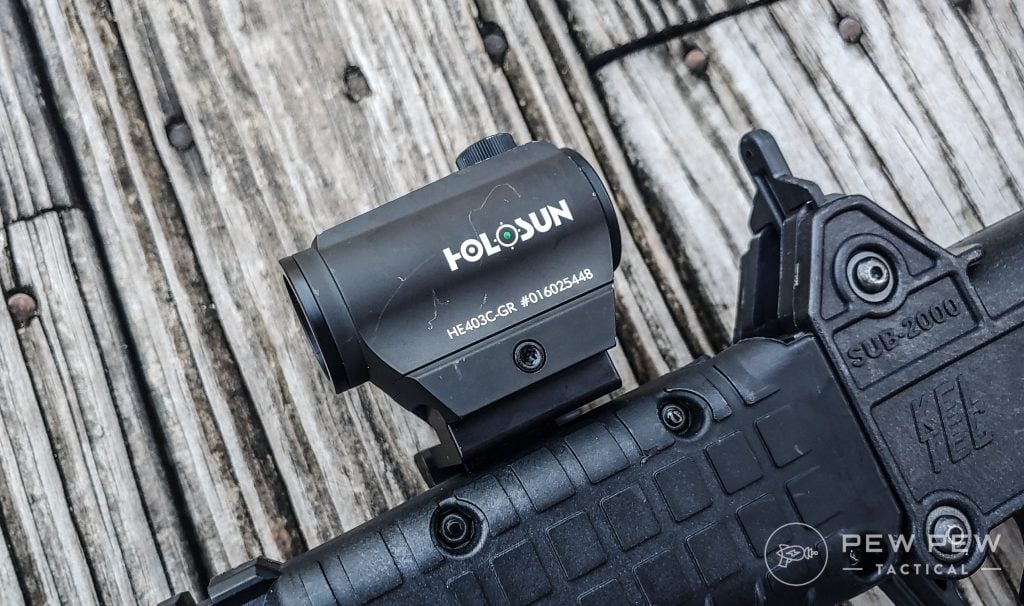
3. Vortex Strikefire II
Prices accurate at time of writing
Prices accurate at time of writing
-
25% off all OAKLEY products - OAKLEY25
Copied! Visit Merchant
Pros
- Rugged & durable
- Wide field of view
- Compatible with wide selection of rings
Cons
- Large and heavy
- 4 MOA may linmit long distance shooting
Specs
Features
The Vortex Strikefire II is my pick for people who want a rugged optic that just works, no matter what you throw at it.
This optic is all about speed at close distances. Forgiving unlimited eye relief and a wide field of view will help you get on target in a hurry. The large dot is easy for your eye to pick up. You can also put this optic exactly where you want it on your rifle or carbine because the 30mm tube is compatible with a huge selection of rings.
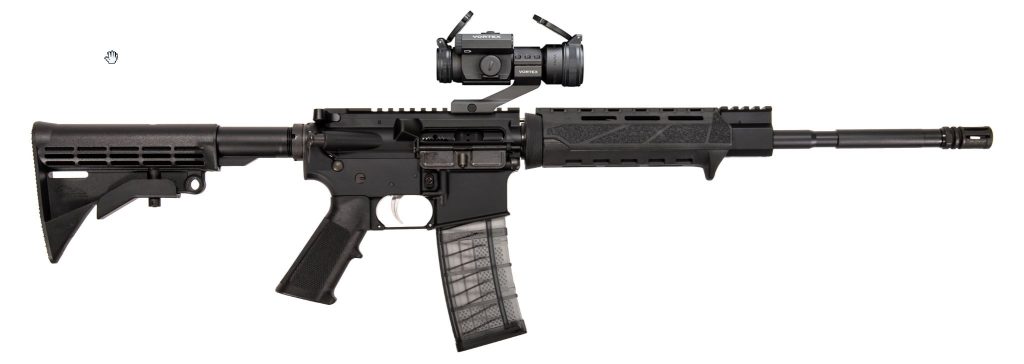
The Strikefire II is a workhorse, but it has downsides, too. It’s larger (5.6 inches long) and heavier (7.2 ounces) than the other red dots here.
The 4-MOA dot is bright and easy to acquire, but it also means you’re looking at a point of aim more than 4 inches wide at 100 yards — not exactly a precision instrument.
If you want a red dot that’s affordable, tough, and backed by the unbeatable VIP Warranty, this is the one for you.
4. Primary Arms Classic Series Mini
Prices accurate at time of writing
Prices accurate at time of writing
-
25% off all OAKLEY products - OAKLEY25
Copied! Visit Merchant
Pros
- Very affordable
- Up to 40K hours of battery life
- Uses Trijicon RMR footprint
Cons
- May not be as durable as other models
Specs
Features
Don’t forget about pistol optics!
During our hands-on review, we found the Primary Arms Classic Series Mini to be a great introduction to the world of pistol optics for people who are tight on cash or hesitant to ditch their iron sights.
The Classic Series Mini uses the popular Trijicon RMR mounting footprint, so it’s compatible with a huge variety of modern pistols. There are also adapters available if you want to mount this as an offset optic on a Picatinny rail or as a primary sighting system on a shotgun rib.
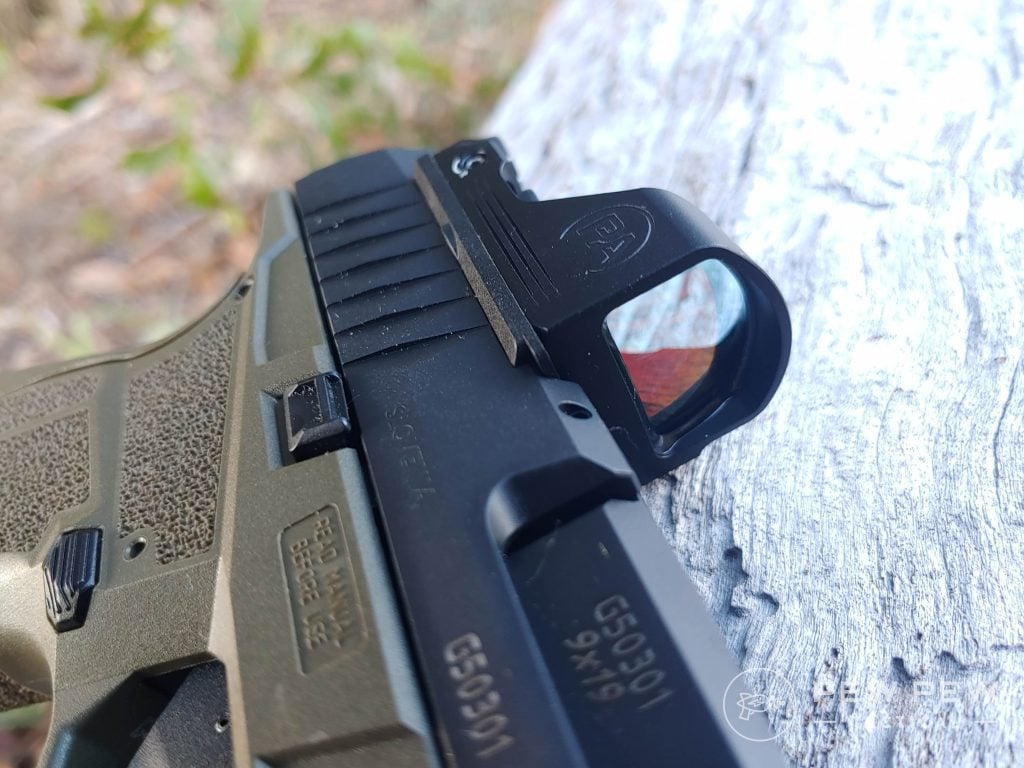
The 24-millimeter window offers a nice field of view, and the rounded hood makes it a little less likely to print if you use this on your CCW pistol. The 3-MOA dot and 1-MOA adjustment increments might not sound ideal compared to a rifle red dot, but they’re perfectly adequate for practical pistol work. Primary Arms claims a battery life of up to 40,000 hours.
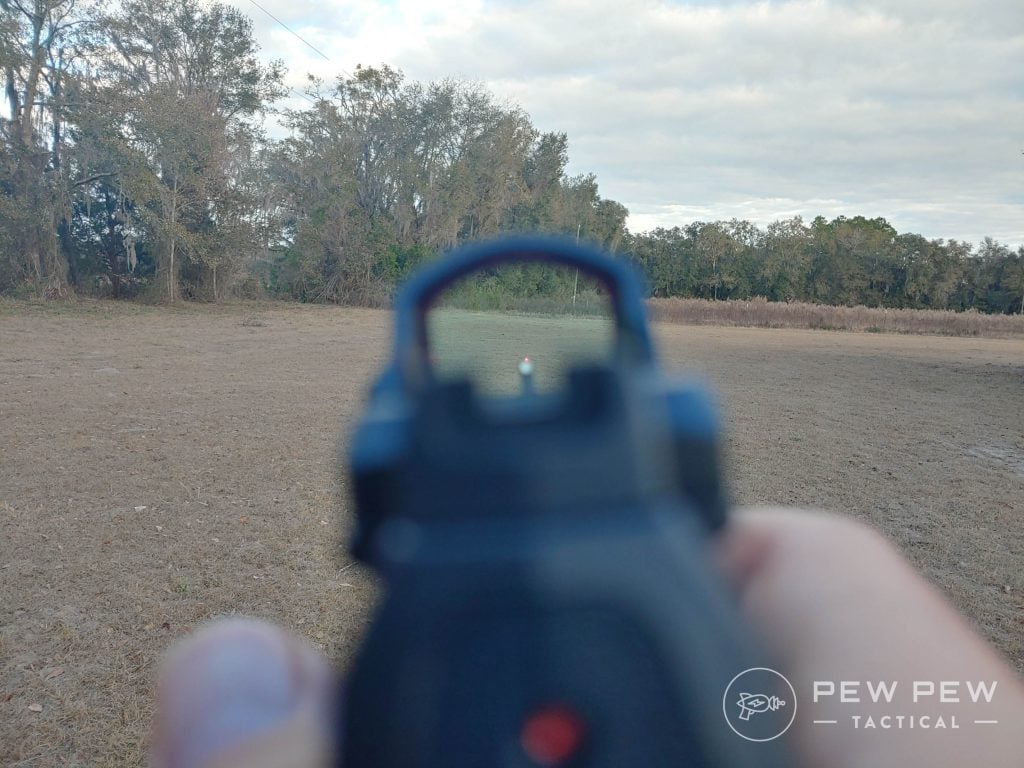
It’s a great entry point into the world of pistol optics and reliable enough for light carry or home defense use. Durability isn’t competitive with more expensive pistol optics, though, so if you’re going to put your duty gun through the wringer, it’s worth spending more for something more robust.
Why Are These So Affordable?
Nothing in this life is free. If you save money on your red dot, you’re going to pay for it in other ways.

Durability
If you’ve ever watched a torture test, you know that cheap optics don’t handle abuse as well as expensive ones. Even a short drop onto a hard surface can crack the glass on an inexpensive optic, even before you mount it on a firearm.
That might not matter if you’re setting up a pistol to live in your nightstand drawer and never leave your carpeted bedroom. If durability is important to you, spend a few more dollars for something with a proven track record of toughness.
Clarity
If you look through two optics side by side, it’s usually pretty obvious which one costs more. Inexpensive optics may cut costs in glass quality and the coatings that are applied to each surface of the glass.
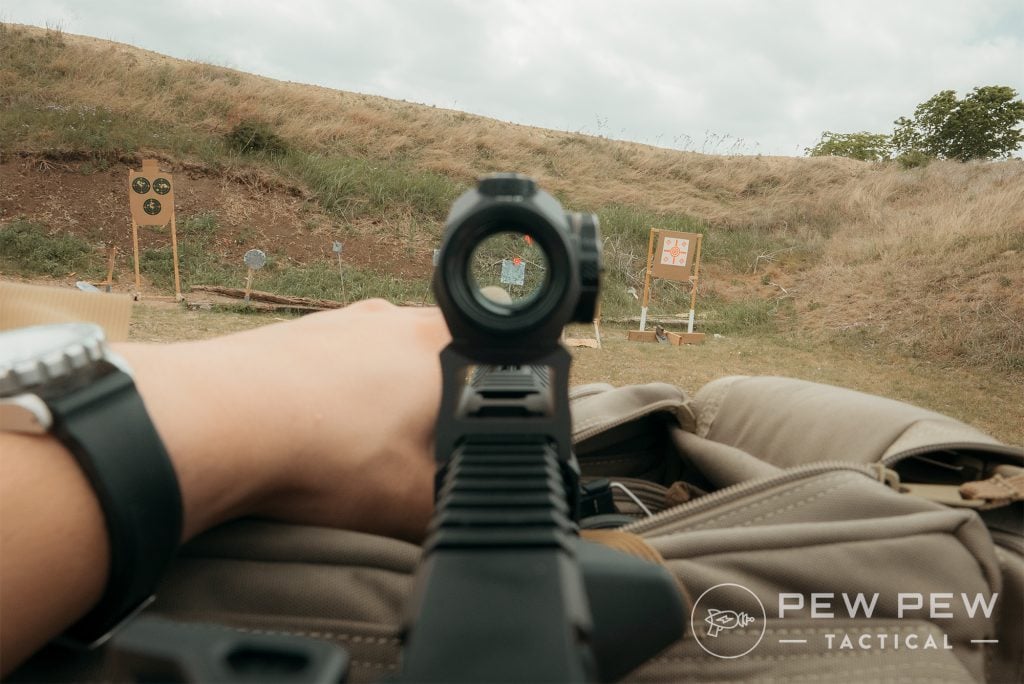
Again, only you can decide how much clarity is worth paying for. The more shooting you do and the more accuracy is required, the more it makes sense to buy a high-end optic.
If all you need is something a little bit better than iron sights, go ahead and save some cash for ammo.
Battery Life
Affordable red dots don’t usually suffer from reduced battery life. That’s because battery life is easy to measure and understand, but clarity (a related factor) is more subjective.
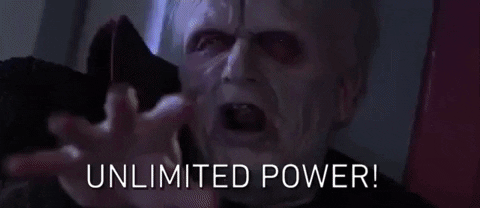
Have you ever noticed that some red dot optics look crystal clear, and some have a blue tint? That color affects more than the quality of your image.
As the clarity of glass increases, so does the amount of energy it takes to achieve a crisp, bright dot. You might notice that inexpensive red dots tend to have either long battery life or a super clear window — but not both.
Why Red Dots Are Better Than Iron Sights, Anyway
It’s 2024, so there probably aren’t many people still clinging to the idea that iron sights are better than a red dot. The bigger question is whether they’re better than the least expensive red dots on the market.
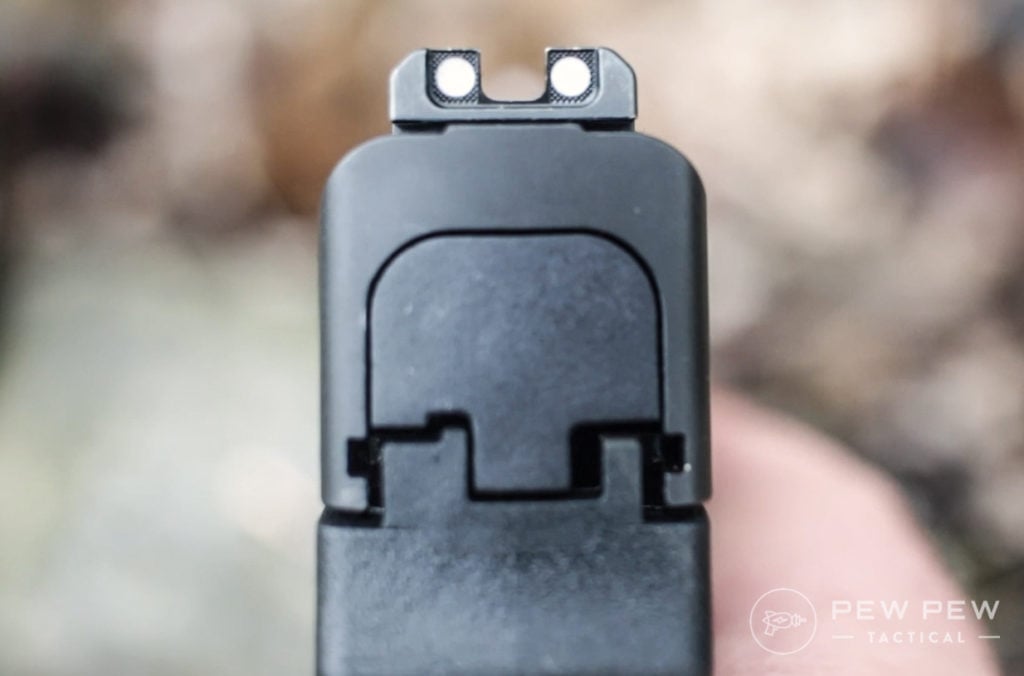
Iron sights will always have an edge in durability because as long as you’re looking through glass, there’s an additional point of failure. One point for irons.
There are several reasons why any red dot optic — even one that costs less than $200 — is a better sighting system, though.
Speed
It doesn’t matter how fast you are with iron sights; you would be faster with a red dot, given a modest amount of training.
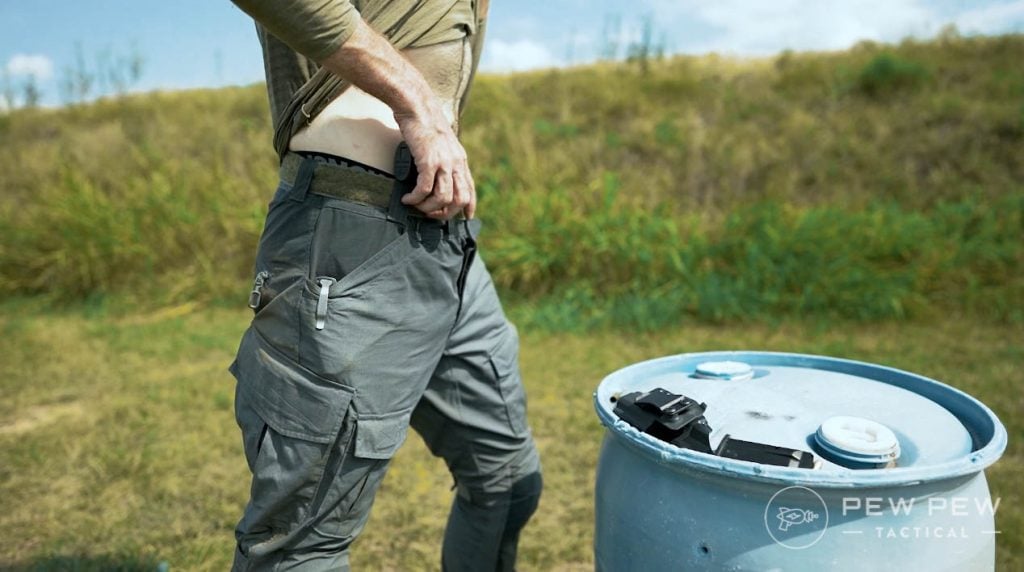
When you use iron sights, you’re lining up three planes: the rear sight, the front sight, and the target. Getting all of those aligned takes more time than putting a glowing red ball on your target and pulling the trigger.
Situational Awareness
Using traditional sights requires us to close one eye. That immediately cuts our field of view in half.
Viewing the world through one eye isn’t a problem when you’re focused on shooting tight groups at a known distance in a controlled environment, but it’s not ideal anywhere else.
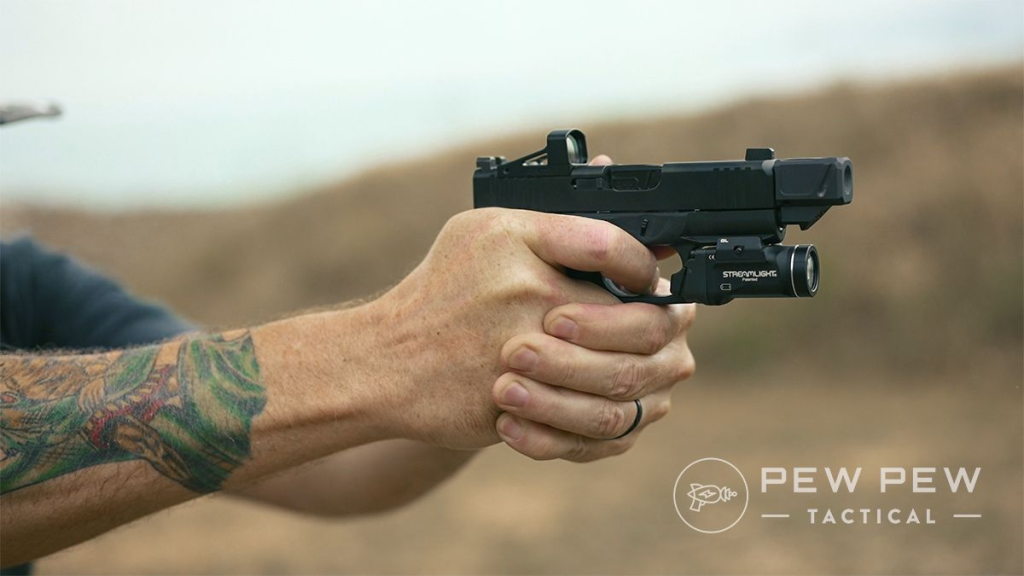
If you’re setting up your home defense or CCW gun, it’s obvious why you need to know what’s going on around you. The same goes for hunting and dynamic competitive shooting.
Accuracy
This one can go both ways, but I give red dots the edge in most cases.
Dialing elevation adjustments on certain iron sights (looking at you, A2 carrying handle) can make for surprisingly accurate shooting out to at least 500 yards.
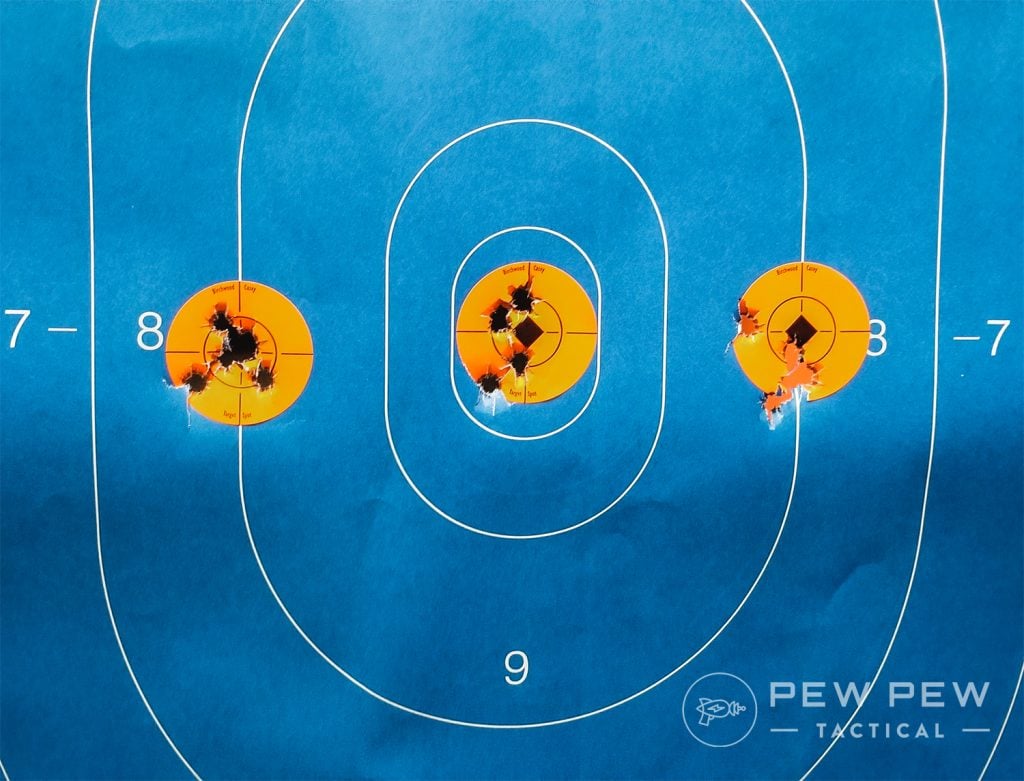
In most cases, people aren’t concerned with shots like that. Getting a front sight post perfectly centered in a rear notch or peep sight will involve more human error than what you’d experience due to the size of your dot reticle or the lack of readily accessible mechanical adjustments.
This all assumes that you know how to zero iron sights, which is easier said than done on some firearms.
Final Thoughts
Affordable gear usually can’t compete with top-shelf competition, but there are times and places when it makes sense to pinch your pennies.
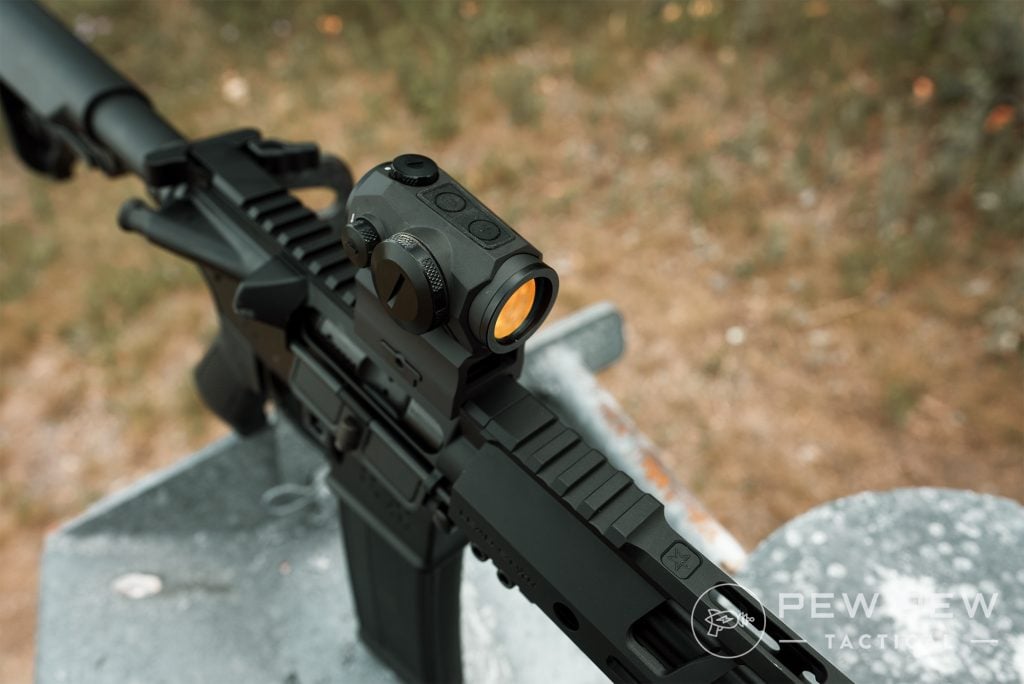
If you’re currently using the stock iron sights on your pistol, backup iron sights on your carbine, or a bead sight on your shotgun, even an entry-level red dot can be a nice upgrade. Just know its limitations, don’t ask too much of it, and start saving money so you have the option to upgrade down the road.
Any other budget red dots you’d like to see? What do you currently run on your AR? Want to go cheaper? We now have a Best Under $100 Red Dots article and video.

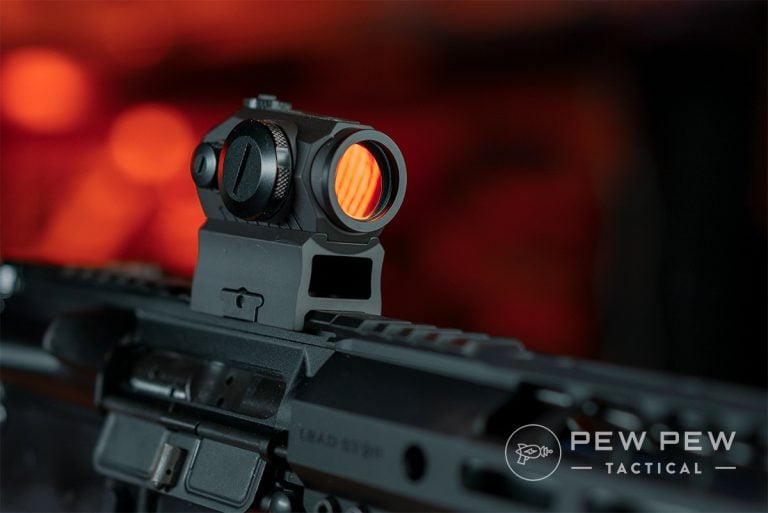
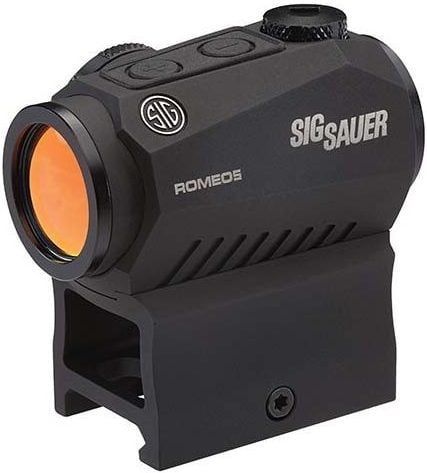

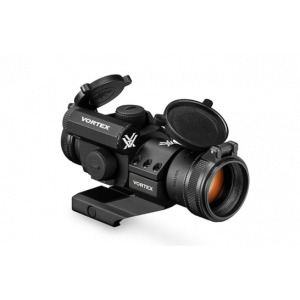




78 Leave a Reply
Any of these strong enough to handle a 12 gauge shooting deer slugs?
Things not mentioned batteries AAA can be bought virtually anywhere. They do seem to commonly leak. The CR2032 button cells are also easy to find and they are fairly inexpensive.
In terms of glass coatings. Some make it very difficult to clean the optics. Out shooting very few will bring proper lens cleaners with them. Electronic stuff, it is interesting to see how rapidly quality goes up and prices go down.
"But sometimes all you need is an entry-level red dot if the alternative is iron sights"
....not if its made in communist China you don't.....
Wake the ____ up people.
I totally 100% agree with you, but if any business wants to produce something domestically and sell products competitively the heavy taxation hand-cuffs that force businesses out of the country just to bring prices down by (literally) 175% need to go first. I work for a manufacturer of products...that's exactly how much more the same item would sell for if produced domestically. The answer isn't to produce/buy/sell domestically at 175% more...the answer is to reduce the incentive to produce overseas and remove the taxation to produce domestically, but we all know that people will never wake the ____ up and change the laws here.
:'(
99.2% of red dots, and scopes for that matter, are made in China. Even most of the ones that they claim are not, are.
......My Aimpoint isn't.
What mount is being used in the photo with the Holosun on the Sub 2000?
Not that red dots are intrinsically better than iron sights as I had better shots with iron sights (30 years ago when there were no red dots). However, 30 years of aging and my eyes not what they were half a lifetime ago, Rred dots are the way to go for me. I still am no where near as accurate as I was 30 years ago.
Ruger now sells their own red dot, the Ruger ReadyDot. It has no electronics and no battery; it operates by fiber optics. If there is any light, and if you aren't aiming into bright light, you can easily see the dot. In my opinion, the Ruger ReadyDot wasn't made for competition shooting, but rather for a regular guy like myself, who just wants to easily hit what he is shooting at.
The dot is big, so it is easy to see when you are trying to acquire the target. It is made for the Ruger Max-9, so if that's the gun you are shooting, you just line up the front site, the rear site, and the red dot, and you will hit your target. I hit a quart of oil at about 15 yards.
Very easy, very dependable. And only $100.
Please update this article for 2021/22. There are a lot more budget red dot options around now and not enough comparison articles! Hoping you can review (or eliminate) some of the more popular budget red dots today, like the AT3 RCO, Falke, Firefield, Sightmark, etc.
We're working on it!
Was this ever updated?
Not yet. We're waiting until after SHOT Show in mid-January to gather all the latest dots and then test them. Stay tuned!
Earlier this year I purchased the Vortex SPARC Red Dot and I’ve put it on my 300 Blackout. I will be using it for my Missouri deer hunt this November and I can’t wait!! It doesn’t have fixed sights, so I obviously took out the shim. Do you recommend a fixed sight? Thank you! email is as followed
The PA unit is made by Holosun, kust like the Sig Romeo (another affordable option) . Not sure about the Vortex.
You need to check out Tacticon Armament, combat veteran own and made in America.
Great red dot!
I got the email pushed out today about the article that's now two years old. Any updates?
Another vote for the Sig Romeo 5. The shake to wake feature is a must-have for HD. And the auto-shutoff is great for battery life. It can easily be paired with Sig's Juliet 4 magnifier. Plus, the thing is super durable as seen in this video, where a guy shoots it with a shotgun and it continues working
What about the Sig Romeo 5? Better than all of the options in my opinion with the 50,000 hour battery life and the MOTAC automatic shutoff after 2 minutes of being still. Costs under $200 PSA has them on sale now for $120
Any chance for a review for the updated Vortex Cross Fire and Sparc AR models?
They're on our list!
The Holosun is no longer available from Amazon... maybe an updated Choice? Thank you!
The Holosun 403B is the same red dot, with a very slightly different mount - but it's a more common mounting system so that is kind of a plus!
Looking to get into a Rimfire Challenge with my 10/22 Take Down. Would any of these work? I am going for lightweight. Would the Burris Fastfire III be a better option?
I got the the Romeo 5 on sale for 100 bucks ans it rocks. Shake to turn on, turns off dropped 2 times so far and no damage. Love this dot and comes with riser. Absolutely awesome on 9mm ar pistol
I wonder if the 3 budget red dots are applicable to a 12g shotgun autoloader. Can they withstand the stress?
Missing Sig Sauer Romeo 5.... Just saying for $128 is a pretty good deal.
We have a full hands-on review of the Sig Sauer Romeo5! Next time we update this article, we'll be adding it in.
Do re dot sights need to be zerod?
Strike Fire II & Spitfire 1x for me
Any new players in this category post-shot show? Any updates on the Romeo 5... seems to be getting good reviews in comments and other places I've checked... and is coming in at 124 on Amazon today (02/07/2019).
We have a DEEP dive review of the Romeo 5 in the works right now - major abuse tests and everything! Early reports are very positive though. You can find it for a bit cheaper from Palmetto State Armory than on Amazon, $119 shipped right now.
From an ret-Operator, if given the Romeo5 I wouldn't have any concerns. It does not have the crisp dot as Aimpoint but it's really not far apart enough that I would be concerned. I think it gives those looking to purchase Eotech and Aimpoint another less expensive option. Why it was listed as Honorary Mention and was listed below Primary Arms is disturbing and am getting the feeling that those who perform these tests are shy of a novice level knowledgebase. .
"Not recommending Primary Arms" because you dropped it on the edge of eye box and broke glass? Lol the holosun is the same optic lol minus a few features. I have all 3 and the PA is definitely the best of the bunch hands down
Many people seem to be bringing up the lack of an auto on feature for the vortex, however I don't see this as an issue. Whenever I pick up my rifle to go to the range I've made it habit to check the chamber, and turn on the sight. Even if I were to forget when I flip up the lense covers, the first time I attempt to get a sight picture I will instantly notice and it only takes a fraction of a second to flip it on. so I see that as a non issue
If you are using this for Home Defense you want the sight to come on when you grab the gun. Not saying the other sights are bad but I have 2 Holosun's.
I agree 100%!
IMPORTANT things you forgot to mention that make the HOLOSUN even more dominant.
1) HOLOSUN makes models, like PA, with batteries on the side. They also make SOLAR AND Battery models, which will work outside with a dead battery.
1) The HOLOSUN has an AUTO-ON feature that works very well (if a mouse farts within a foot of your gun, it'll come back on for you). This means you don't have to leave the dot on ALL the time (burning battery and shortening LED life). You mentioned the auto-off feature, but I didn't see the AUTO-ON mentioned (I have no idea if VORTEX has it).
2) The HOLOSUN offers a CIRCLE-DOT reticle (like EOtech) that many people prefer--it definitely can help you shoot faster, but it also allows you to just use the 2MOA dot if you want. I think HOLOSUN and PA may offer the PA designed ACSS reticle, but for a non-magnified lens, it's not a big help in my opinion.
While PA says it's a 3 year warranty, they're so cool, I bet they'd replace anything that went bad within 5 years or more. Holosun also seems to do well with any warranty work. Vortex of course does.
In my opinion, the HOLOSUN 503GU is tougher and I think the glass is less tinted than the old design of the 403 model you used here. While it is their BASE model, I've bought a 503GU for $199, so it should have been used in the testing in my opinion.
** I'd be interested in the $180 to $250 range, which would include the SIGs (which APPEAR to be made by the same company as HOLOSUN and PA, though I've heard they deny that), which seem to get good reports also (though maybe the extra price is JUST for the SIG name). You'd also get into the better Holosuns (assuming you couldn't find a 503GU on sale), and even the Holosun 510C model, which has a LOT more of an open viewing area design.
What about the Weaver Micro Red Dot? If you get it on sale its practically disposable.
I've never laid hands on their micro dot, but the scopes I've had were really crummy.
Sig’s Romeo 5 takes the prize for me. Rugged, 2MOA, HUGE battery life, auto shut-off, and most importantly, motion sensitive auto-on! No fumbling for a switch = one less thing to think about. Includes both absolute and 1/3 co-witness options. Life time warranty.
ditto kiddo. Love mine too. One less thing to think about.
Same as holosun and primary arms
Provide actual evidence. Not your usual anecdotal bs, but actual proof. The glass is all the same factory, but everything else is assembled by each company. Plus both companies deny it.
I read your reports on the red dots and the holographic sights. Which do you prefer and why?
Thanks
I just opened my Aimpoint PRO. Spent more $$ but I’m very impressed. It’s built like a lank and if you had to, throwing it at the enemy’s face would cause considerable damage.
how do you leave Bushnell TRS 25 off of this list? Solid competitor and a screaming value... Id be interested to know how it measures up to the next tier red dots
Hi Peter, we cover it in our overall Best AR-15 Optics, but for this test it was more about red dots with high battery life I would trust on a defensive rifle.
For the $45 I paid for one new, they're a great DEAL. However, the tint and battery life are pretty bad (days/weeks/or months, but not years), and mine has no auto-off....I think it just kills the battery when you leave it on (unless it's at like 3 or 4). Mine are usually on 6 or 7 UNLESS I'm shooting for accuracy, when I turn it way down.
I don't own a red dot yet, so this may be a dumb question, but, if running a red dot with both eyes open, wouldn't the size of the viewbox be somewhat irrelevant? I've read articles that say your eyes will reconcile the dot on target, even with the front lens cap on. What's your opinion? Thanks. P.S. I always look forward to your Pew Pew articles over that first cup of coffee in the morning. Keep 'em coming!
It gets a little distracting if the viewbox is very small since one eye is still behind it. And sometimes when you want to aim more precisely and close one eye, you're going to want the bigger viewbox.
... and more importantly smaller viewbox = less light through the glass in low light situations.
Good point!
What red dot would you use on a glock 19
Hi Brad, I'm using a Trijicon RMR Type 2 with 3.25 MOA.
I'll keep my Leupold 1-4X scope on my .300 Blackout. I have a vortex Viper on my racegun, but to me they have no place on a rifle. But that's just my opinion. If a red dot works for you I'm happy for you.
You do realize that the Army issues Aimpoint Red-Dots to all of their soldiers issued M-4's. I don't think your opinion is valid when compared to 243 years of combat experience.
Just found your site, and thanks for the info. In the 5 months since your publish date the Holosun link to Amazon now gives the price starting at $161.50. The Vortex still goes for $199. Does having the price difference basically cut in half change your Editor's Choice? I have to admit I was liking the Holosun while reading, but witt the pricing now I'd be leaning toward the Vortex due to the warranty.
Hey Brent, the Amazon prices for the Holosun seem to fluctuate a little bit. But my recommendation still stands especially the Vortex is still holding at $199.
Ah ur article is very dated and Holo makes PA?
Hey, could you help me out with which part I should be updating? And as far as I know, they do.
What do you guys think about the AT3 Tactical LEOS red dot?
I purchased one for my 300 blackout build, just wondering if anyone has used one.
Grest info, you guys always have informative articles.
Hey Felix, no experience with that one...let us know how it goes for you. Might look at it for an update of this article.
Felix what did you think of the AT3 red dot, i have the AT3™ LEOS™ Red Dot Sight with Integrated Laser Sight & Riser and wish the red dot was brighter at 50 yards, thanks
What do you think about the Sig Romeo 5?
Hey Mike, I haven't had experience with it yet but it's on my short list of red dots to try out this year.
I would suggest checking out the Romeo 5 and especially the Romeo 4. The Romeo 4 has an entire line with different options, but I got the 4A (only 2 moa dot option) for $155 on sale. The Romeo 4 has clearer glass than the 5 and is compatible with all the Aimpoint mounts while the 5 is stuck like the Vortex AR, although my Romeo 4A hangs slightly forward on the American Defense mount I use. It doesn't bother me, but it doesn't look identical to the Aimpoints.
Sig has a lifetime warranty like Vortex, but there is some confusion over the 3-year electronics warranty. PA just rolled out it's warranty on some optics, but it is yet to be tested. I do like PA as a retailer overall. Holosun can be hit or miss depending on the exact model number. I bought an early model and researched the exact model number first and it held zero on my 12 gauge through hundreds of shells, so I like Holosun, but I like Sig's offering better.
It's coming up a lot...I'll have to check them out when I update this article!
I'd sure like to see about what magnifiers will flip up and align with these out of the box. The Sparc AR seems just a tad lower.
The problem is that manufacturers (and reviewers LOL) don't give the height to center info. On the flip side, the mag people don't give much either (except the UTG 3X).
I recently bought the Vortex Strikefire II with the VMX-3T magnifier. One of them came with a riser (sorry at the office and can't remember which). But after adding it they lined up completely level. Either purchase manufacturer to manufacturer or buy the appropriate riser for one of them. Just my 2 cents.
Well written and appears very concise and objective in testing these sights without the appearance of trying to promote or sell one brand over another...as so many 'reviews' on other sites seem to do. Good job.
Thanks so much Dave!
Good read here Eric, very informative. I just finished building my AR and I am currently on the hunt for some optics. Currently serving in the ARNG and when we go shoot, all our M4's are equipped with either ACOG or CCO red dot (pretty much the aimpoint compM4). I really like the red dot we use cause I am use to it and shoot it well, but i also dig the acog cause the magnifier. I do want to purchase an ACOG but damn the price. Looking into the vortex spitfire 3x. Any thoughts anyone? or is there a red dot somewhere out there with a magnifier?
I like the Spitfire 3x and there's also a good amount of 1x optics (aimpoint, eotech, etc) that have flip-capable magnifiers.
A 1-4x or 1-6x short dot scope could fill the gap. It gives you the option of a red-dot like experience with no magnification, but gives you the option to dial up the magnification to operate like an ACOG. The downsides are the weight, size, parallax, finicky eyebox especially while magnified, and loss of flip up sights/cowitness unless you use offsets. Entry level 1-4x or 1-6x scopes are around the $150-200 mark, like these red dots, while the next step up ranges from $300 to 600.
Otherwise there are flip-to-the-side magnifiers for red dots or prism sights like the Vortex.
Purchased the Vortex for $139/shipped from PSA and it seems pretty good thus far. I do admit that I like the look of the smaller sized red dots a tad better, but not too worried about it... If I would have done it over again, I would have still went with the Vortex, simply because of the AWESOME lifetime warranty. You may not need the warranty for many years, but if/when you do, it's always gonna be there for ya and it's fully transferable if you decide to sell it and upgrade to a better dot later on. Thanks 4 the review...
Do you think the Vortex Sparc II would have fared better or worse? It's the one I got since it wasn't "AR specific". Also, keep up the great work, I really enjoy the content here. You guys have a lot of interesting information along with good explanations.